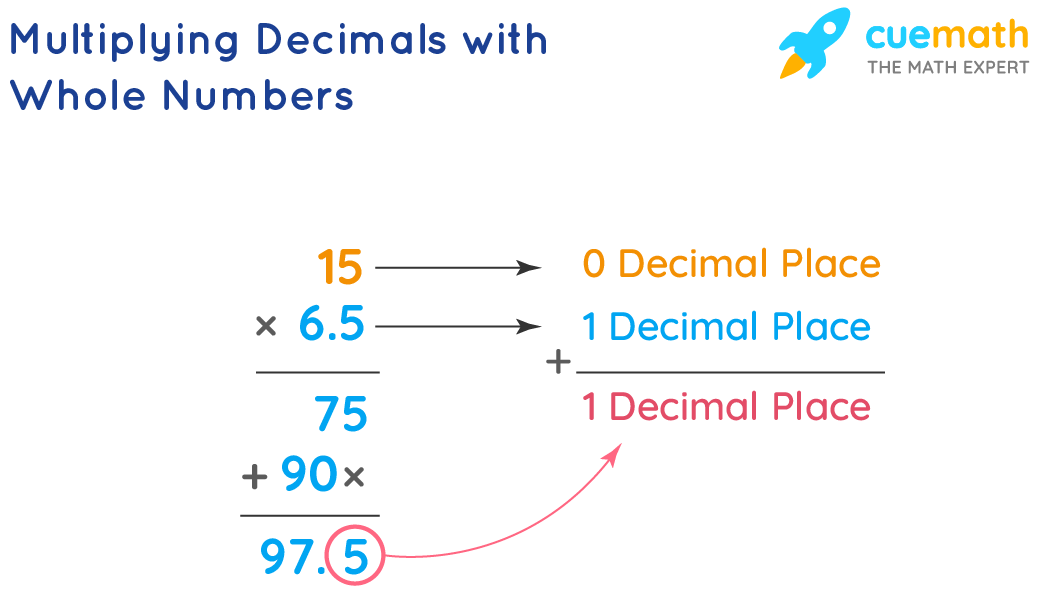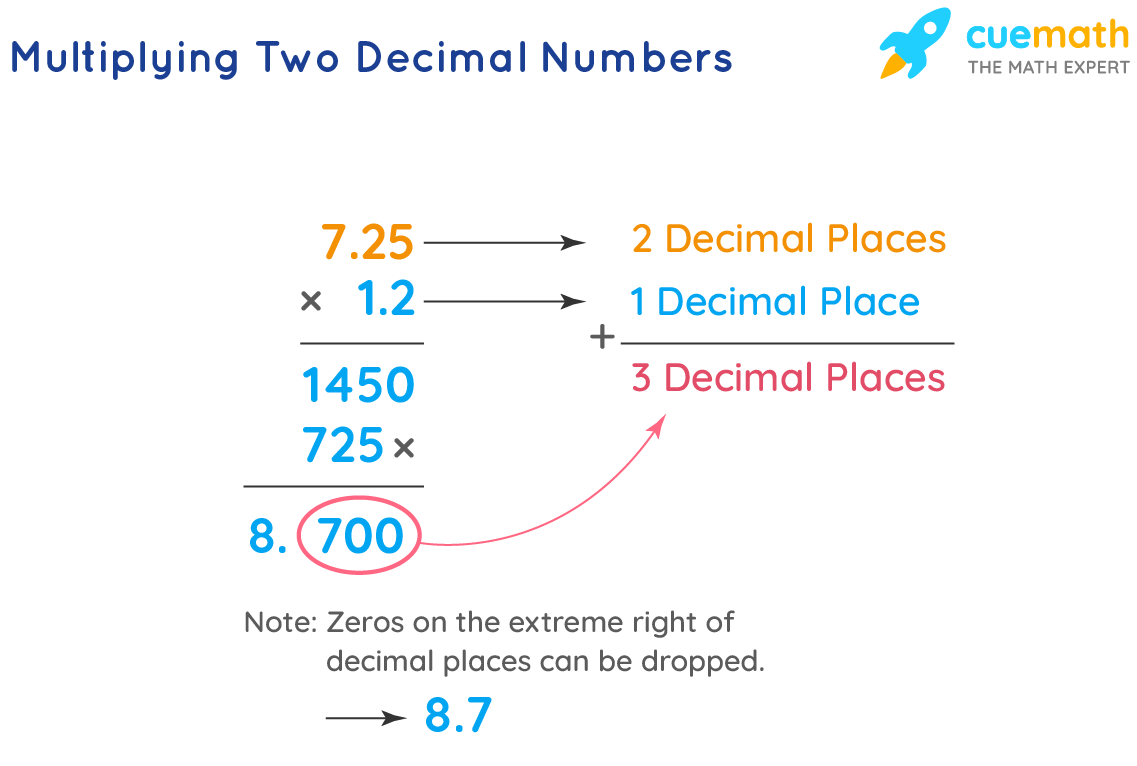Multiplying Decimals
Multiplying decimals is very important when we talk about the grouping of items. Suppose you have to distribute 0.25 part of a chocolate bar to each child and there is a total of 12 children. How many chocolate bars would you need? To find the number of chocolate bars required, we have to multiply 12 by 0.25. Multiplication of decimals is done by ignoring the decimal point and multiply the numbers, and then the number of decimal places in the product is equal to the total number of decimal places in both the given numbers.
| 1. | How to Multiply Decimals? |
| 2. | Multiplying Decimals with Whole Numbers |
| 3. | Multiplying Two Decimals Numbers |
| 4. | FAQs on Multiplying Decimals |
How to Multiply Decimals?
Multiplying Decimals has the same procedure as that of multiplication of the whole numbers, except the placement of the decimal point in the product. In our everyday life, we have come across various instances where we have to use the multiplication operation on two numbers out of which at least one or both are decimal numbers. Imagine going out with your friend for lunch. You both order a platter costing $6.75 each. The total bill amounts to $15.75, including the taxes. To calculate the total cost of the platter in the bill, you need to multiply $6.75 × 2. Similarly, suppose you plan to gift your mother a flower bouquet on her birthday. Each flower costs $0.75 and you buy a total of 6 flowers. To find the total cost of the bouquet, you need to multiply $0.75 × 6. The above examples follow the application of multiplying decimals.
Multiplying Decimals with Whole Numbers
Multiplying decimals with whole numbers is similar to the multiplication of whole numbers, the only difference being in the placement of the decimal point. The following steps can be followed to multiply decimals with whole numbers:
- Step 1: Initially, ignore the decimal point and multiply the two numbers normally.
- Step 2: After multiplication, count the number of decimal places in the decimal number. The product obtained after multiplication will have the same number of decimal places.
- Step 3: Place the decimal point in the obtained product following Step 2.
Let us understand a real-life situation of multiplying decimal numbers with whole numbers. A class of 15 students decided to contribute to a relief fund. Each student made a contribution of $6.5. What was the total amount collected from the whole class? Here, the contribution made by one student = $6.5. Total contribution made by 15 students = 6.5 × 15= $97.5.

Multiplying Decimals by 10 100 and 1000
While multiplying any decimal by 10, 100, 1000, or any other power of 10, we just simply shift the decimal point towards the right as many places as the number of zeros in the power of 10.
- If we multiply a decimal by 10, we shift the decimal point one place towards the right, as there is 1 zero in the number 10.
- If we multiply any decimal by 100, we shift the decimal point two places towards the right.
- Similarly, if we multiply a decimal by 1000, we shift the decimal point by three places towards the right, and so on.
For example, 2.32 × 10 = 23.2, 2.32 ×100 = 232, 2.32 × 1000= 2320.
Multiplying Two Decimals Numbers
This section will help you to learn about the multiplication of two decimal numbers. It is the same as that of the whole number, but the only difference is that in this we have to take the sum of the total number of decimal places in both the given numbers and that needs to be equal to the number of decimal places in the product. To multiply two decimals, follow the steps listed below:
- Step 1: Initially, ignore the decimal point and multiply the two numbers normally.
- Step 2: After multiplication, count the total number of decimal places in both the numbers. The product obtained after multiplication will have this total number of decimal places.
- Step 3: Place the decimal point in the obtained product following Step 2.
Let us see the multiplication of two decimal numbers in the image given below:

Examples of Multiplying Decimals:
1. Multiply 0.567 and 13.065

Therefore, 0.567 × 13.065 = 7.407855. There are 6 digits after the decimal point.
2. Find the product of 16.45 and 8.5

Therefore, 16.45 × 8.5 = 139.825. The product has 3 digits after the decimal point.
Important Notes:
These are few important notes related to the concept of multiplying decimals. Have a look!
- The decimal multiplication follows the same procedure as the multiplication of whole numbers.
- The decimal point should be placed in the product in such a way that, the product has a number of decimal places equal to the sum of decimal places of all the multiplicands and the multipliers.
- Make sure you keep all the zeros in the product while placing the decimal point.
- If the product has more decimal places than the number of digits, zeros can be inserted on the left before placing the decimal point in the product.
- The trailing zeros in the resultant product can be dropped.
Try and Solve these Challenging Questions:
- Charlie is paid $17.45 per hour and worked 42.5 hours last week. How much money did he earn last week (rounded to the nearest cent)?
- What is the total distance covered by a car if it traveled with a speed of 31.5 miles/hour for 7 hours and 15 minutes?
Multiplying Decimals Related Topics
Check these articles related to multiplying decimals.
Multiplying Decimals Examples
-
Example 1: Rose is learning decimal multiplication. Can you help her multiply 0.6748 with 14.945?
Solution:
Let's see how to multiply 0.6748 and 14.945.

Note: The trailing zeros can be dropped. Therefore, 0.6748 × 14.945 = 10.084886.
-
Example 2: Gracy went to the grocery store with her mother. Her mother bought 15 apples costing $1.25 each. Help Gracy to calculate the amount her mother needs to pay by using the concept of multiplying decimals.
Solution:
We have, cost of one apple = $1.25. Thus, cost of 15 apples = $1.25 × 15. Therefore, the cost of 15 apples is $18.75.


FAQs on Multiplying Decimals
How do you Multiply a Decimal Number by a Whole Number?
To multiply a decimal number by a whole number, follow the steps given below:
- Step-1: Ignore the decimal point and multiply both the numbers.
- Step-2: Count the number of decimal places in the decimal number.
- Step-3: Then, place the decimal point in the product such that the number of decimal places in the product and the original decimal number should be the same.
How do you Multiply Decimals by 1000?
To multiply decimals with 1000, shift the decimal point three places towards the right, as there are three zeroes in 1000.
How to Teach Multiplying Decimals?
Let us see how to teach decimal multiplication to learners through the following ways:
- First, make students understand the meaning of decimal multiplication with the help of demonstration and visualization.
- Second, introduce the steps to multiply two decimal numbers to the students.
- Give practice questions.
What is the Rule of Multiplying Decimals?
The multiplying decimals rules are given below:
Rules for Multiplication of Decimals:
- Perform multiplication in a similar way as with whole numbers.
- If the product has more decimal places than the number of digits, zeros can be inserted before placing the decimal point in the product such that only one zero will be there at the left of the decimal point and the decimal places in the product will be equal to the total number of decimal places in both the numbers.
- The decimal point should be placed in the product in such a way that, the product has a number of decimal places equal to the sum of decimal places of all the multiplicands and the multipliers.
- The trailing zeros in the fractional part of the resultant product can be dropped.
How do you Multiply Decimals Less Than 1?
To multiply two decimals less than 1, follow the steps given below:
- Step 1: Initially, Ignore the decimal point and multiply the two numbers normally.
- Step 2: After multiplication, count the total number of decimal places in multiplicand and the multiplier. The product obtained after multiplication will have this total number of decimal places.
- Step 3: Place the decimal point in the obtained product following Step2.
For example: 0.2 × 0.4 = 0.08.
How do you Multiply Positive and Negative Decimals?
Positive and negative decimals are multiplied in a similar way as two decimals.
- Multiply both the numerical parts as we do in normal decimal multiplication.
- Since the product of one negative number and one positive number is negative, thus retain the negative sign before the numerical part of the product hence obtained.
For example, -0.5 × 0.3 = -0.15.
visual curriculum
